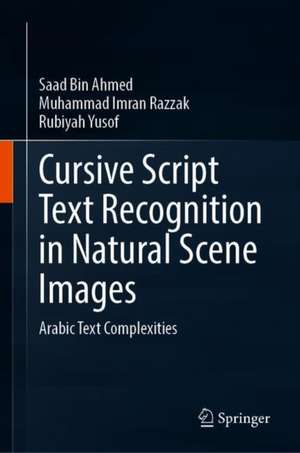Cursive Script Text Recognition in Natural Scene Images: Arabic Text Complexities
Autor Saad Bin Ahmed, Muhammad Imran Razzak, Rubiyah Yusofen Limba Engleză Hardback – 7 feb 2020
This book offers a broad and structured overview of the state-of-the-art methods that could be applied for context-dependent languages like Arabic. It also provides guidelines on how to deal with Arabic scene data that appeared in an uncontrolled environment impacted by different font size, font styles, image resolution, and opacity of text.
Being an intrinsic script, Arabic and Arabic-like languages attract attention from research community. There are a number of challenges associated with the detection and recognition of Arabic text from natural images. This book discusses these challenges and open problems and also provides insights into the complexities and issues that researchers encounter in the context of Arabic or Arabic-like text recognition in natural and document images. It sheds light on fundamental questions, such as a) How the complexity of Arabic as a cursive scripts can be demonstrated b) What the structure of Arabic text is and how to consider the features from a given text and c) What guidelines should be followed to address the context learning ability of classifiers existing in machine learning.
| Toate formatele și edițiile | Preț | Express |
|---|---|---|
| Paperback (1) | 579.03 lei 38-44 zile | |
| Springer Nature Singapore – 7 feb 2021 | 579.03 lei 38-44 zile | |
| Hardback (1) | 585.96 lei 38-44 zile | |
| Springer Nature Singapore – 7 feb 2020 | 585.96 lei 38-44 zile |
Preț: 585.96 lei
Preț vechi: 732.46 lei
-20% Nou
Puncte Express: 879
Preț estimativ în valută:
112.13€ • 116.36$ • 93.73£
112.13€ • 116.36$ • 93.73£
Carte tipărită la comandă
Livrare economică 11-17 martie
Preluare comenzi: 021 569.72.76
Specificații
ISBN-13: 9789811512964
ISBN-10: 9811512965
Pagini: 111
Ilustrații: XV, 111 p. 63 illus., 57 illus. in color.
Dimensiuni: 155 x 235 mm
Ediția:1st ed. 2020
Editura: Springer Nature Singapore
Colecția Springer
Locul publicării:Singapore, Singapore
ISBN-10: 9811512965
Pagini: 111
Ilustrații: XV, 111 p. 63 illus., 57 illus. in color.
Dimensiuni: 155 x 235 mm
Ediția:1st ed. 2020
Editura: Springer Nature Singapore
Colecția Springer
Locul publicării:Singapore, Singapore
Cuprins
Foundations of Cursive Scene Text.- Text in a wild and it’s Challenges.- 3 Arabic Scene Text Acquisition and Statistics.- Methods and Algorithm.- Progress in Cursive Wild Text Recognition.- Conclusion and Future Work.
Notă biografică
Dr. Saad Bin Ahmed is a lecturer at King Saud bin Abdulaziz University for Health Sciences, Riyadh, Saudi Arabia (KSAU-HS). He is also associated with Center of Artificial Intelligence and Robotics (CAIRO) research lab at the
Malaysia-Japan International Insitute of Technology (M-JIIT), Universiti Teknologi Malaysia, Kuala Lumpur, Malaysia. He completed his Ph.D. in Intelligent Systems at the Universiti Teknologi Malaysia in 2019. Before that, he completed his Master of Computer Science in Intelligent Systems at the Technische Universität, Kaiserslautern, Germany, and was a research assistant at the Image Understanding and Pattern Recognition Research Group at the same university. His areas of interests are document image analysis, machine learning, computer vision, and optical character recognition. He has authored more than 25 research articles in leading journals and conferences, as well as book chapters.
Dr. Muhammad Imran Razzakis associated with the University of Technology Sydney, Australia. Previously, he was an Associate Professor at King Saud bin Abdulaziz University for Health Sciences. He holds a patent and is also the author of more than 70 papers in respected journals and conferences. He has secured research grants of more than $1.3 million, and has successfully developed and delivered several research projects. His areas of research include machine learning, document image analysis, and health informatics.
Prof. Dr. Rubiyah Yusof is a director at (CAIRO) M-JIIT, Universiti Teknologi Malaysia, Kuala Lumpur, Malaysia. She received her master’s degree in Control Systems from Cranfield Institute of Technology, United Kingdom, in 1986, and her Ph.D. in Control Systems from the University of Tokushima, Japan, in 1994. Throughout her career, Dr. Yusof has made significant contributions to artificial intelligence, process control, and instrumentation design.
She is recognized for her work in biometrics systems, such as KenalMuka (face recognition system) and a signature verification system, which won both national and international awards. She is the author of the book Neuro-Control and its Applications published by Springer-Verlag, in 1995, which was translated to Russian in 2001. Professor Dr Yusof is a member of the AI Society Malaysia, Instrumentation and Control Society Malaysia, and Institute of Electrical and Electronics Engineers Malaysia.
Textul de pe ultima copertă
This book offers a broad and structured overview of the state-of-the-art methods that could be applied for context-dependent languages like Arabic. It also provides guidelines on how to deal with Arabic scene data that appeared in an uncontrolled environment impacted by different font size, font styles, image resolution, and opacity of text.
Being an intrinsic script, Arabic and Arabic-like languages attract attention from research community. There are a number of challenges associated with the detection and recognition of Arabic text from natural images. This book discusses these challenges and open problems and also provides insights into the complexities and issues that researchers encounter in the context of Arabic or Arabic-like text recognition in natural and document images. It sheds light on fundamental questions, such as a) How the complexity of Arabic as a cursive scripts can be demonstrated b) What the structure of Arabic text is and how to consider the features from a given text and c) What guidelines should be followed to address the context learning ability of classifiers existing in machine learning.
Caracteristici
Offers a broad and structured overview of state-of-the-art methods Introduces and briefly describes the characteristics and complexities Highlights the problems involved with Arabic scene text Discusses evaluations using big data Provides deep insights into the problems associated with Arabic script languages and how to overcome them
